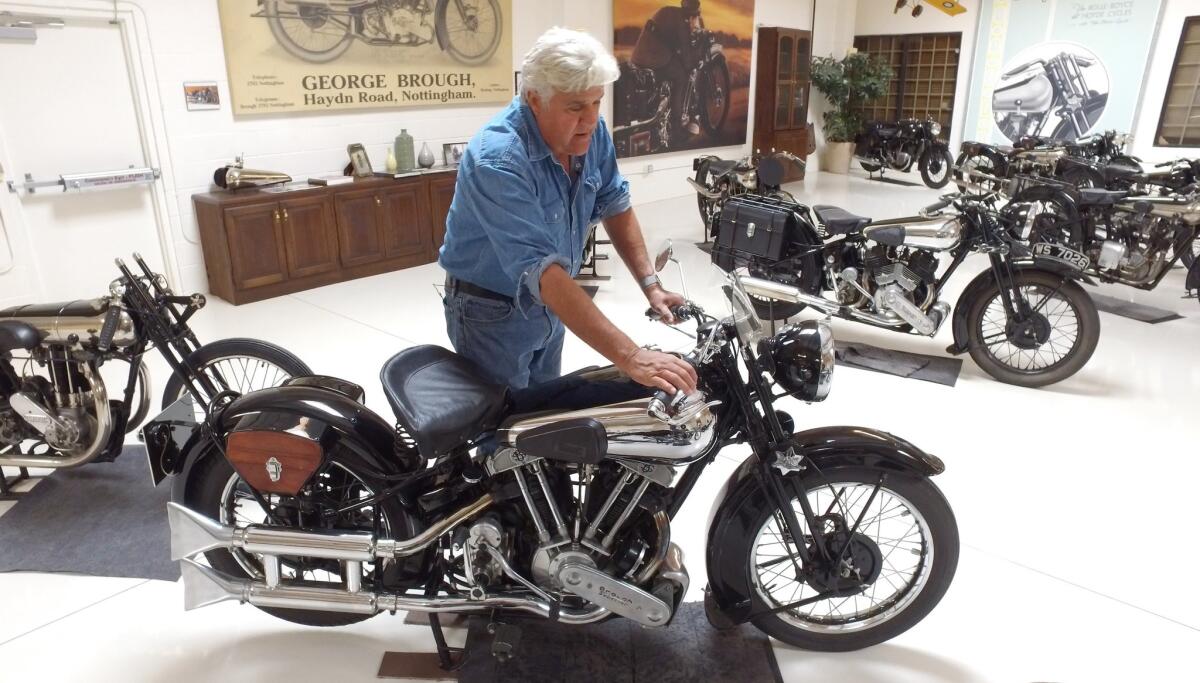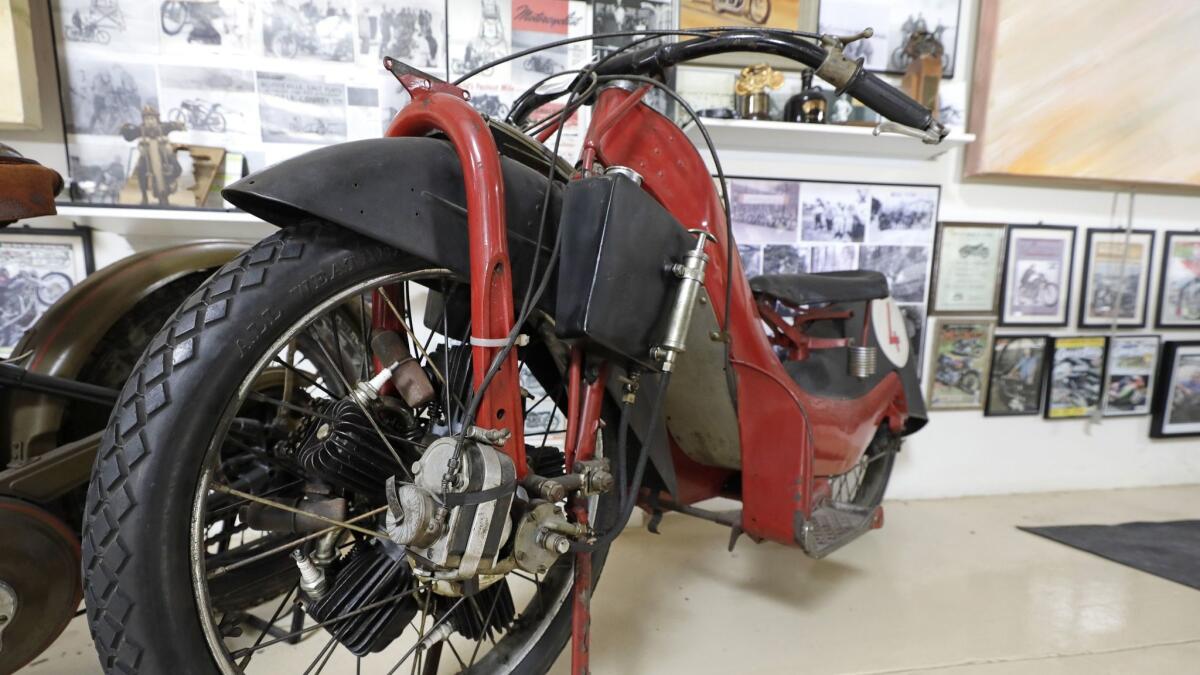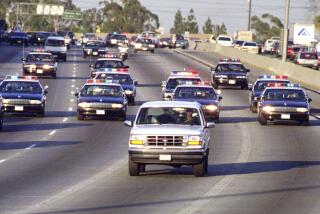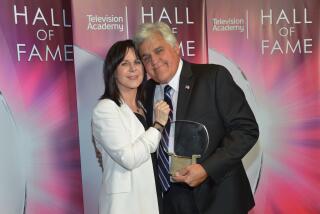Jay Leno gives a glimpse of his vast motorcycle collection

Jay Leno is as famous for his vintage cars as he is for his comedy, thanks to his long-running “Jay Leno’s Garage” TV show.
But the former late-night host is just as passionate about motorcycles as he is about cars, and just as knowledgeable. Leno has one of the most interesting collections of two-wheeled machines, and recently took us on a tour of his museum-like gallery.

Jay Leno collects unique and unusual motorcycles.
It includes the world’s most extensive collection of Brough Superiors, which to some collectors is the finest motorcycle ever made, and which Leno calls “the first superbike.”
Leno bought his first Brough in the 1980s, paying $5,000 for a 1939 model that his friends scoffed at.
“People thought, ‘You’re out of your mind. That’s crazy — five-thousand dollars,’” Leno remembered. “But now they’re half-a-million-dollar motorcycles.”
The machines were known for their speed at a time when most motorcycles didn’t go very fast. The Broughs were regularly clocked at over 100 miles per hour — “a ton,” in the slang of the day — in the 1920s.
Leno acknowledges that they went fast better than they stopped. Their brake technology, standard for the times, wasn’t very effective.
“You don’t really stop,” he said. “You try to retard progress. You practice accident avoidance.”
Vintage machines like the Broughs require the operator’s total attention, and a good deal of maintenance, and even then are as likely to fall apart as stay together.
“With older motorcycles like this, people aren’t amazed that you got there that quickly,” Leno said. “They’re amazed that you got there at all.”
Leno was almost poetic about the charm of riding vintage bikes, even as he acknowledged that faster, safer and much more dependable motorcycles can be had for less money — and considerably less work.
“There’s a great sense of mechanical satisfaction,” he said. “You control your own destiny. If it stops running, you try to get a spark and some fuel and some air and you get it running again. You feel like you’ve really accomplished something.”

Jay Leno’s extensive motorcycle collection includes an impressive mix of Brough Superiors.
Leno’s first motorcycle was a 350cc Honda that he purchased when he was a student because “it was cheap transportation.” He later began trading up, and acquiring more esoteric examples.
Parked here and there in his Burbank facility, between motorcycles made by Vincent, Triumph, Norton, BSA, AJS, Harley-Davidson, Indian and an array of German, Italian and Japanese companies, are real rarities.
Over there is an original, unrestored 1918 Pope. Nearby is a gorgeous Henderson Four that Leno bought from a 92-year-old man. (“He had to sell it because he was getting a divorce,” Leno explained.)
Against a wall is probably the rarest bike in the entire collection, a 1922 Megola, with a five-cylinder radial engine attached to the front wheel.
Down the hall there’s the 375-horsepower Y2K bike, powered by a helicopter engine, that has been tested at 237 miles per hour.
“It’s basically a jet. You kind of strafe when you go down the road,” Leno said. “You’re so glad when you get off it.”
There is also a set of electric motorcycles and scooters, in a group not far from a rare Nimbus, a rare Rudge and an early Whizzer.
Many of these have appeared or will appear on television and online as part of “Jay Leno’s Garage,” now in its fourth season. Episodes of older shows are also archived on YouTube.

As with his cars, Leno is deeply informed about every motorcycle in the garage. Strolling between them, he tosses out facts, figures and quirky bits of trivia about where he found them, how much they cost when new, how much he paid for them, what he had to do to get them running, and how they compare with other motorcycles.
And, like the cars, the motorcycles are all gassed up and charged up and ready to ride.
Like his fellow connoisseur Bruce Meyer, Leno doesn’t believe in collecting to collect, and he doesn’t buy bikes to flip. He buys what he likes to ride or drive, spends whatever is necessary to restore them, and never sells anything.
“If you buy what you like, and you’re reasonably astute, chances are other people will like it, too,” he reasoned. “Hopefully the value rises. It doesn’t make any difference to me, because I would never sell them.”
As he ages, Leno said he has become increasingly aware of the dangers of falling, but wants to continue riding as long as he feels he can do it safely.
“I think I’ve only got one good crash left in me,” he said, “I’m 67, so the writing is kind of on the wall. But, what can I tell you? It makes me smile.”
And he said he is happy that, nowadays, his television appearances are mostly limited to discussions of motor vehicles, about which he is passionate and very well informed. That’s very different from his days hosting late-night television.
“I was never really a sports guy, or an entertainment guy, so I always had to kind of fake it — like, ‘Who’s that guest? What did he do?’” Leno said. “Now, I’m usually talking about stuff that I actually enjoy.”







